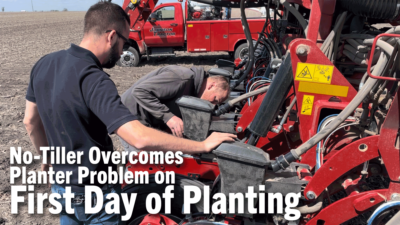So you’re doing the right thing — no-tilling your farm ground and planting cover crops when moisture allows so you can improve soil health and hopefully keep more of the limited rain and snow falling in your area.
Earthworms have started coming back, organic matter is inching up and, hopefully, beneficial insects are returning and helping with pest control.
But to some, you’re still a commodity farmer destroying nature. In an article, “Farmers Imperil Diversity for Even Lower Yields,” Fern’s Ag Insider cites a new study asserting U.S. corn, soybean, and wheat fields have wiped out an expanse of native grasslands and other ecosystems larger than the state of Maryland — “destroying crucial wildlife habitat and spewing carbon dioxide into the atmosphere. And the new fields produced lower crop yields than existing farmland.”
The publication says from 2008-16, more than 10 million acres of marginal land were cropped for the first time in 6 years, with some of it not touched in decades. Much of this happened, they say, in the “Prairie Pothole” region, which stretches from northern Iowa through much of the Dakotas into northeastern Montana and southern Canada. Other hot spots include western Kansas, western Kentucky, and the North Carolina foothills.
Using satellite data validated with farmer surveys and high-resolution aerial photography from the USDA, Tyler Lark, an agriculture researcher at the University of Wisconsin-Madison, and colleagues analyzed the expansion’s impact on farmers and wildlife.
Among other things, Lark’s team says cropland expansion wiped out more than 200 million milkweed plants, which serve as the only plant its caterpillars can eat. An estimated 138,000 potential nesting sites for ducks and other birds were also lost, the researchers found. The prairie pothole region has historically produced half of the nation’s waterfowl.
Lark and his colleagues reported in their paper, published this month in Nature Communications, that yields on the converted land were, on average, nearly 7% lower than those on existing farmland.
Along with rental incomes being higher on land rented to commodity farmers than ranchers, the “rise of no-till planting” makes it easier to convert grasslands to crops, farmer Lyle Perman said in the article. “You can apply Roundup on native grass and start no-till farming it literally the same year.”
A fourth-generation farmer and rancher who owns Rock Hills Ranch in Lowry, S.D., Perman says the answer to the loss of grasslands is simple: more cows and fewer crops, with high-intensity grazing and animals being moved more often.
The presence of livestock give landowners and farmers a financial reason not to convert grasslands, he says. “If you cannot figure out how to keep cows on the landscape, you’re in trouble,” Perman says. “You lose the cows, you lose water quality, you lose air quality, you lose species diversity.”
I can relate to the argument the authors make against ever-growing farm expansion. With some key herbicides not performing well and facing legal trouble, demand for organic products skyrocketing and conventional grain prices not recovering from their doldrums, one might wonder if converting millions of acres was worth it. With no-till practices you can manage larger farms more easily without embarking on all the tillage passes, but how many acres do you need to be profitable?
Ignored in this article, though, are the contributions no-tillers and progressive ranchers are already making toward biodiversity. Cover crops planted after harvest or interseeded into growing cash crops will ultimately improve both soil health and biodiversity. And no-tilled soils likely sequester more carbon than tilled soils do.
It’s easy to criticize, but I give a hats off to no-tillers who are already doing the right thing.







Post a comment
Report Abusive Comment